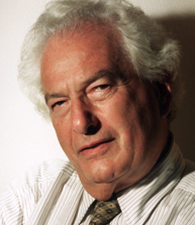Brooklyn-born author Joseph Heller is best known for coining the phrase “Catch-22” in his tragicomic World War II novel of the same name.
Joseph Heller’s Early Days
Joseph Heller was born on May 1, 1923, to Russian-Jewish immigrants living in Brooklyn. His father died when he was only 5, and Heller spent much of his life knowing little about him. Heller’s youth took place around the amusement park and beach of Coney Island.
Heller graduated from high school in 1941, and soon after the United States entered World War II Heller joined the Army Air Corps and spent two years flying combat missions in Corsica as a bombardier.
After the war, Heller married Shirley Held and began studying at NYU. Later he earned an advanced degree in English from Columbia University and earned a Fulbright scholarship at Oxford. After his education he returned to the academic world for a few years, teaching English at Penn State in the 1950s before turning to a career in advertising copywriting.
Sources in this Story
- Encyclopedia.com (Encyclopedia of World Biography): Joseph Heller
- Columbia University: Columbia 250: Joseph Heller
- The New York Times: Joseph Heller, Darkly Surreal Novelist, Dies at 76
- The New York Times: No Laughing Matter
Heller’s Notable Accomplishments
While Heller was working in the publishing industry in advertising, he began to write short stories, publishing works in Esquire and Atlantic Monthly. It was through writing short stories that he was inspired to write his most famous novel, “Catch-22.”
Drawn from his own experiences in World War II, the story’s protagonist is a World War II pilot named Yossarian who attempts an insanity plea to stop having to fly dangerous missions. The term “catch-22” refers to an intractable set of rules that make any choice or escape impossible. When Yossarian pleads insanity to avoid missions, his desire to avoid combat is seen as a mark of his sanity: and thus he cannot be excused from combat.
The bleak comedy of “Catch-22” is something that Heller saw as a punishment to the reader: he puts the characters in a situation characterized by death and destruction, and yet provides amusement for the reader; Heller wants the reader to feel ashamed that he or she is amused, even though the outlook for the characters is dim. The dark humor of Heller is often compared to that of Kurt Vonnegut.
Although “Catch-22” was published in 1961, the book did not find a large following until the late 60s, during the Vietnam War. It was made into a film in 1967 by the writer and director of “The Graduate,” Buck Henry and Mike Nichols.
Heller went on to write several successful novels, including “Good as Gold” (1979), “God Knows” (1984) and “Closing Time” (1994), a complementary book to “Catch-22” that reprised many of the earlier book’s characters.
These three all displayed Heller’s dark humor and surrealist tendencies, but no book fared as well in sales as “Catch-22,” which has sold more than 10 million copies. The New York Times reports that when an interviewer mentioned to Heller that he had not written anything else as good as “Catch-22,” Heller replied, “Who has?”
The Man and His Work
The Rest of the Story
In 1986, Heller was diagnosed with the nerve disease Guillain-Barre syndrome, which eventually paralyzed him. He spent more than six months in hospitals and medical facilities. In addition to his physical ailments, Heller had to borrow money from friends to pay for his treatment because he had neglected to make a payment on his insurance.
Eventually Heller was able to recover from the often-fatal ailment, and out of his experience came a book, “No Laughing Matter,” written in chapters authored alternately by himself and his friend Speed Vogel (who until then was not a writer). Heller puts himself up to the same dark humor he uses with all of his characters, as he and Vogel found humor in the way that friends such as Mel Brooks and Mario Puzo interact with Heller.
Known as a somewhat ornery man, Heller fascinated friends and strangers alike with the way that he found the ridiculous or humorous in situations that were bleak or even morbid. He died from a heart attack on December 12, 1999, at the age of 76. After his death, Simon & Schuster published “Portrait of an Artist, as an Old Man,” a semiautobiographical novel about an aging writer in search of a subject.











